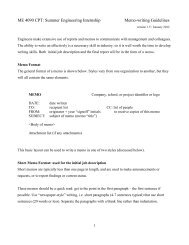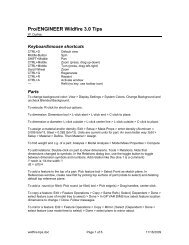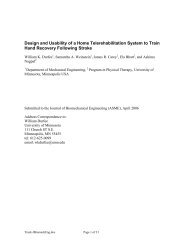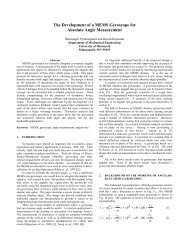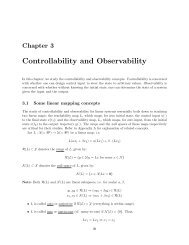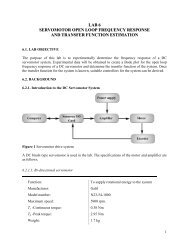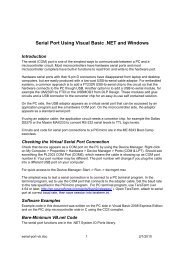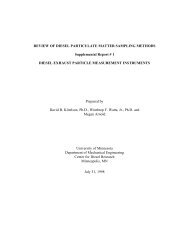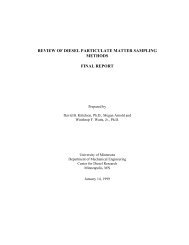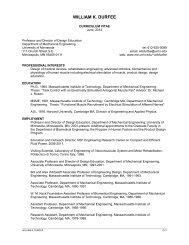A Design Tool for Aerodynamic Lens Systems - Department of ...
A Design Tool for Aerodynamic Lens Systems - Department of ...
A Design Tool for Aerodynamic Lens Systems - Department of ...
Create successful ePaper yourself
Turn your PDF publications into a flip-book with our unique Google optimized e-Paper software.
322 X. WANG AND P. H. MCMURRY<br />
aReynolds number <strong>of</strong> 200 downstream <strong>of</strong> sudden expansions.<br />
Our design tool constrains Reynolds numbers (Re) tobebelow<br />
200. There<strong>for</strong>e,<br />
Re = ρ1ud f<br />
µ = 4 ˙m<br />
πµd f<br />
≤ 200. [1]<br />
Although sonic or supersonic nozzles have been widely used<br />
to focus particles (Murphy and Sears 1964; Israel and Friedlander<br />
1967; Cheng and Dahneke 1979; Dahneke and Cheng 1979;<br />
Fernández de la Mora et al. 1989; Mallina et al. 2000; Tafreshi<br />
et al. 2002), we constrain the flow through lenses to be subsonic<br />
to avoid the complicated influence <strong>of</strong> shock waves on particle<br />
focusing. There<strong>for</strong>e, the lens Mach number (Ma) islimited to<br />
be smaller than the value corresponding to choked flow (Ma ∗ )<br />
(Wang et al. 2005a), i.e.,<br />
Ma = u<br />
c < Ma∗ . [2]<br />
If the flow is in the free molecular regime, the particle inertia<br />
would greatly exceed the drag <strong>for</strong>ce and no focusing could be<br />
achieved. Furthermore, rarefied gas dynamics is too complicated<br />
to handle using our simple design tool. There<strong>for</strong>e, we restrict the<br />
flow Knudsen number (Kn)tobesmaller than 0.1 to assume that<br />
the flow is continuum,<br />
Kn = 2λ1<br />
d f<br />
< 0.1. [3]<br />
Focusing <strong>Lens</strong><br />
The parameter that governs particle focusing through an aerodynamic<br />
lens is the Stokes number (St), which is defined as the<br />
ratio <strong>of</strong> the particle stopping distance at the average orifice velocity<br />
(u) tothe orifice diameter (d f ):<br />
St = τu<br />
d f<br />
= 2ρpd 2 pCc ˙m<br />
9πρ1µd3 , [4]<br />
f<br />
where Cc = 1 + Knp(1.257 + 0.4e −1.1<br />
Knp ) and Knp = 2λ1/dp.<br />
As shown in earlier studies, the particle contraction factor (ηc),<br />
which is the ratio <strong>of</strong> terminal to initial radial positions <strong>of</strong> the<br />
particles travelling through the lens, is a strong function <strong>of</strong> the<br />
Stokes number: |ηc| ≈1 when St ≪ 1, |ηc| < 1 when St ≈ 1,<br />
and |ηc| > 1 when St ≫ 1. In other words, small particles<br />
follow gas streamlines and thus are not focused, intermediatesized<br />
particles are focused and large particles are defocused by<br />
the lens. There exists an optimum Stokes number (Sto) <strong>for</strong> which<br />
ηc = 0 (Liu et al. 1995a). Liu et al. showed that the contraction<br />
factors are independent <strong>of</strong> the particle initial radial position <strong>for</strong><br />
particles that are not too far away from the axis. We refer to these<br />
near-axis contraction factors unless stated otherwise.<br />
By rearranging Equation (4), we can calculate the diameter<br />
<strong>of</strong> the lens aperture <strong>for</strong> optimally focused particles:<br />
�<br />
2ρpd<br />
d f =<br />
2 pCc � 1<br />
˙m 3<br />
. [5]<br />
9πρ1µSto<br />
Note that the optimal Stokes number is a function <strong>of</strong> flow<br />
Reynolds number, Mach number, and lens geometry (Liu et al.<br />
1995a; Zhang et al. 2002). We use thin plate orifices as the focusing<br />
elements in this paper. Liu et al. (1995a) showed that<br />
the dependence <strong>of</strong> Sto on the constriction ratio (β)<strong>of</strong>thin plate<br />
orifices becomes weak when β ≤ 0.25. To simplify the design<br />
process, we use β ≤ 0.25 in the design tool. In principle, one<br />
could use β>0.25 if the ηc vs. St curves were known.<br />
To obtain the relation between Sto, Ma, and Re, wehave<br />
carried out numerical simulations <strong>of</strong> particle motion through a<br />
single lens at a range <strong>of</strong> Mach number (Ma = 0.03–0.32) and<br />
Reynolds numbers (Re = 1–100) which cover the typical operating<br />
conditions <strong>of</strong> lenses. In these simulations, β was set equal<br />
to 0.2. Particles were injected at an initial radial location (r pi)<strong>of</strong><br />
0.15ds from the lens axis and Brownian motion was neglected.<br />
The relationship between the contraction factor and St, Re, and<br />
Ma is shown in Figure 2(a)–(c). Note that the dependence <strong>of</strong><br />
contraction on Reynolds number decreases as Mach number<br />
increases. The dependence <strong>of</strong> the contraction factor on the particle<br />
initial radial location becomes significant <strong>for</strong> large Stokes<br />
numbers (Liu et al. 1995a). There<strong>for</strong>e, the near-axis contraction<br />
factors in Figure 2 are not very representative at the higher St end<br />
<strong>of</strong> each curve, and significant impaction losses occur <strong>for</strong> particles<br />
with St > 10. Figure 3 shows the optimum Stokes number<br />
Sto as a function <strong>of</strong> Re <strong>for</strong> three different Ma, which corresponds<br />
to the St where ηc = 0ateach curve in Figure 2. The value <strong>of</strong><br />
Sto <strong>for</strong> a specific set <strong>of</strong> Re and Ma can be interpolated from this<br />
data.<br />
From Equation (5), we can see that the pressure upstream<br />
<strong>of</strong> the lens is an important parameter in calculating the lens<br />
diameter. There<strong>for</strong>e, we need to accurately estimate the pressure<br />
drop across an orifice. We have developed a model <strong>for</strong> viscous<br />
flow through an orifice<br />
CdY �<br />
˙m = A f � 2ρ1(p1 − p2)<br />
1 − β4 CdY<br />
= A f �<br />
1 − β4 p1<br />
�<br />
2M �p<br />
RT1 p1<br />
as well as <strong>for</strong> the discharge coefficient (Wang et al. 2005a)<br />
Cd =<br />
⎧<br />
0.1373Re<br />
⎪⎨<br />
⎪⎩<br />
0.5 (Re < 12)<br />
1.118 − 0.8873 × Ln(Re) + 0.3953 × [Ln(Re)] 2<br />
− 0.07081 × [Ln(Re)] 3<br />
+ 0.005551 × [Ln(Re)] 4 − 0.0001581 × [Ln(Re)] 5<br />
(12 ≤ Re < 5000)<br />
0.59 (Re ≥ 5000) [7]<br />
[6]



